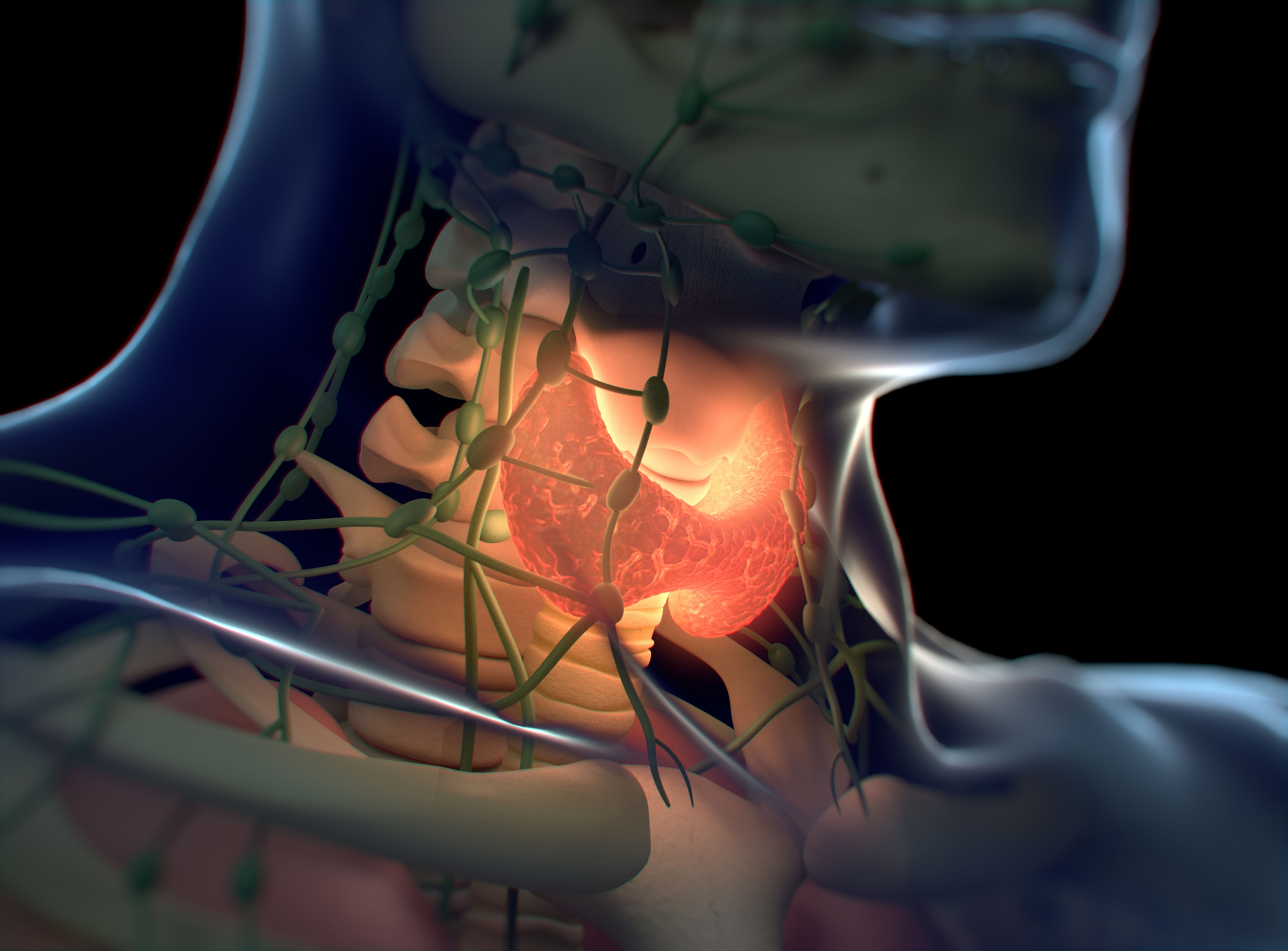MET-Targeted MFGI, Spectroscopy May Detect Papillary Thyroid Cancer
Phase 1 data show that EMI-137 enabled MFGI and spectroscopy differentiation between papillary thyroid cancer–afflicted tissue and healthy thyroid tissue.
Phase 1 data show that EMI-137 enabled MFGI and spectroscopy differentiation between papillary thyroid cancer–afflicted tissue and healthy thyroid tissue.

EMI-137–based molecular florescence-guided imaging (MFGI) and spectroscopy may be used to detect multifocal papillary thyroid cancer (PTC), potentially improving disease staging and treatment selection between hemi- and total thyroidectomy, according to findings from a phase 1 study (NCT03470259) published in the European Journal of Nuclear Medicine and Molecular Imaging.1 Additionally, administration of EMI-137 enabled MFGI and spectroscopy differentiation between PTC-afflicted tissue and healthy thyroid tissue.
Topline data show that 0.13 mg/kg of EMI-137 was the lowest dosage that allowed for differentiation between PTC and healthy tissue, with the smallest PTC focus detected by MFGI at 1.4 mm. Furthermore, when compared with ultrasound, MFGI restaged 80% of disease from unifocal to multifocal PTC.
The phase 1 dose-escalation study population initially consisted of 19 patients. Five undergoing lymph node dissection for recurrent disease were excluded from analysis, leaving 14 patients with histologically confirmed PTC. Patients within this population underwent either hemithyroidectomy (n = 2) or thyroidectomy (n = 12), and 9 patients had multifocal disease.
EMI-137 was administered intravenously at 0.09 mg/kg (n = 1), 0.13 mg/kg (n = 8), or 0.18 mg/kg (n = 5). Altogether, 34 primary PTC tumors were identified on final histopathology, including 14 primary PTC foci and 20 multifocal PTC foci, after bread loaf slicing and correlation to histopathology.
The primary end point for the study was determining the optimal EMI-137 dose for an adequate target-to-background ratio (TBR) in PTC lymph node metastases.2 The secondary end points included safety; feasibility of MFGI to detect nodal metastases; feasibility of spectroscopy to detect PTC fluorescence and lymph nodes; validation of fluorescence; and the distribution, sensitivity, and specificity of EMI-137.
Higher fluorescence signals were observed in PTC foci compared with healthy thyroid tissue across all dosage cohorts with imaging systems.1 Calculated TBRs were 9.67 (range, 2.30-26.27) in the 0.13 mg/kg cohort and 2.45 and 3.55 (1.39-4.27) in the 0.09 mg/kg and 0.18 mg/kg cohorts, respectively.
Similarly, quantitative spectroscopy was affiliated with higher observed fluorescence signals in PTC foci compared with healthy tissue for the 0.13 mg/kg (P < .001) and 0.18 mg/kg (P < .001) cohorts. Mean TBRs were 2.50 (range, 1.57-3.50), 2.69, and 3.47 (range, 2.50-4.39) in the 0.13 mg/kg, 0.09 mg/kg, and 0.18 mg/kg cohorts, respectively.
A clear cytoplasmic EMI-137 signal in PTC foci was confirmed through cross-sectional confocal fluorescent microscopy imaging. Additionally, observed EMI-137 concentration was significantly lower in healthy thyroid tissue. Similarly, a positive MET staining status was observed in PTC foci yet was barely present in healthy thyroid tissue.
No serious adverse effects (AEs) were observed during EMI-137 administration. A single grade 1 instance of flushing 25 minutes after dosing was observed in the 0.18 mg/kg cohort, which eventually resolved.
To be eligible for enrollment, adult patients needed to have Bethesda VI fine needle aspiration (FNA) thyroid or FNA proven PTC primary or current metastases, be scheduled to undergo central and/or lateral lymph node dissection, and have a World Health Organization performance score of 0 to 2.
Patients were excluded from the study if they had advanced stage thyroid cancer not suitable for resection; concurrent anticancer therapy within 3 months of beginning study treatment; or a history of myocardial infarction, pulmonary embolism, uncontrolled congestive heart failure, significant liver disease, or unstable angina within 6 months before study enrollment.
“MET-targeted MFGI and spectroscopy of primary PTC using EMI-137 are a very promising modality to identify multifocal disease. PTC tumor-specific targeting of EMI-137 was confirmed on both macroscopic and microscopic level. MFGI and spectroscopy could be useful in identifying multifocal disease, ultimately contributing to intraoperative upstaging and subsequent total thyroidectomy,” Madelon Metman, MSc, from the Department of Surgery of University Medical Center Groningen at the University of Groningen, and coauthors concluded.
References
- Metman MJH, Jonker PKC, Sondorp LHJ, et al. MET‑receptor targeted fluorescent imaging and spectroscopy to detect multifocal papillary thyroid cancer. Eur J Nucl Med Mol Imaging. 2024;51(8):2384-2394. doi:10.1007/s00259-023-06525-5
- Precision thyroid cancer surgery with molecular fluorescent guided imaging (TARGET). ClinicalTrials.gov. Updated April 16, 2024. Accessed July 16, 2024. https://clinicaltrials.gov/study/NCT03470259